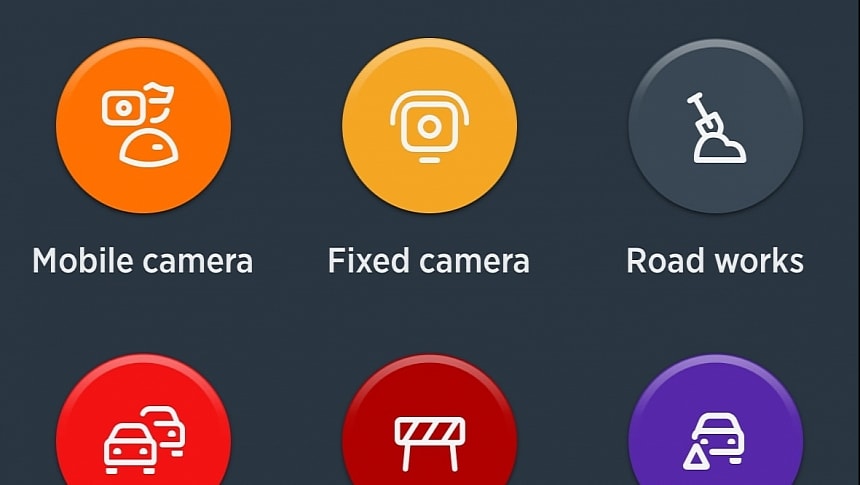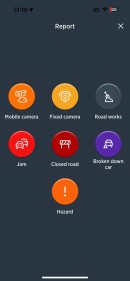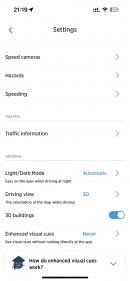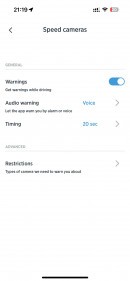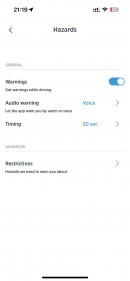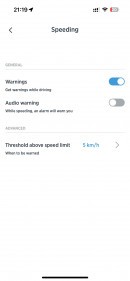Google Maps might be the world's number one mobile navigation app, but Waze is the top alternative, offering features no competitor could copy.
The number one feature of Waze is the incident reporting support, which allows users to mark the location of traffic hazards. Waze uses the community data to generate warnings forwarded to other users on the road, helping make the trip more predictable.
Users receive warnings on the screen, so they get extra time to slow down when they encounter potholes, accidents, speed traps, roadkill, or other hazards.
Many companies have tried to copy Waze's main selling point, but nobody has managed to build a large community to power the crowdsourced capabilities. A community-driven feature makes sense only with enough users to contribute with traffic data.
The best example of a partially failed attempt at building a Waze rival is Apple. The iPhone maker brought incident reporting to Apple Maps, allowing users to report accidents, speed traps, and other generic hazards. The feature is yet to take off, mainly because it's only available in limited regions, and Apple Maps is exclusive to iPhones (whereas Waze runs on iPhone and Android).
Navigation specialist TomTom also joined the battle with an app called AmiGO.
If you've never heard of AmiGO, you probably need to give it a try, as it's a freeware application that combines TomTom's navigation know-how with a concept made famous by Waze. AmiGO tries to make the road more predictable with incident reporting, with the company betting big on the accuracy of the reports submitted by users.
The first thing you must know is that TomTom AmiGO only allows users to submit reports when they drive. If you send a report when you're not in the car, the application ignores it.
AmiGO currently supports four report types: speed cameras, traffic jams, roadworks, and closed roads. Waze comes with a wider range of traffic hazards integrated into the app, but TomTom wanted to stick with the essential categories to keep things simple. I believe the company should also consider adding accidents, as they're (unfortunately) common and typically disrupt traffic by causing significant delays.
TomTom acknowledges that maintaining the report accuracy is a challenge, especially in a community-driven app. People can always contribute with traffic reports, but the parent company has no guarantee that they are accurate. An inaccurate report forwarded to other users could eventually push them to other apps, as nobody likes to be warned about a speed trap that isn't there or an accident that didn't occur (to be honest, I occasionally encounter false Waze reports, too, but thanks to the community, they are removed fast; this is why you should always tap the "Not there" button when you can't confirm a report whose warning landed on your screen).
TomTom says it tries to validate "as many of the reports as possible," and unfortunately, the process takes time and affects how fast warnings appear on the map. The company explains that "it might take some time" before a submission is reflected in the app, so you shouldn't try to send the same report multiple times. If it's not there, TomTom will likely be conducting validation.
The company says the process could take more time for "more drastic changes." For example, if you reported a road closure, AmiGO needs more time to receive confirmation that your submission is accurate so that it won't appear on the map instantly.
TomTom uses an approach similar to Waze's to validate reports, so the application asks other users to confirm that a flagged hazard is indeed at the marked location. The message appears only for users whose routes include the flagged location (albeit you don't have to run with navigation enabled to receive the confirmation request).
Users don't have to respond to each confirmation request, but as in Waze's case, the more users contribute with traffic data (be it original submissions or confirmations), the better the service works. Eventually, TomTom AmiGO becomes more accurate, so users running the app receive accurate warnings.
TomTom faces the same challenge as all the other companies that tried to develop a Waze competitor. It needs to build a solid user base that can contribute with traffic information, and we all know how difficult this can be, especially when most of the world already runs and is satisfied with Google Maps and Waze.
Compared to Apple Maps, TomTom AmiGO is also available on Android, as the mapping solution provider didn't want to limit its application to a single platform. Theoretically, this should help AmiGO build the necessary user base faster and easier, albeit the strategy must also include worthy features to convince users to jump ship from their existing software.
Would you give up on Waze and switch to a competing product if it had similar reporting capabilities? Let me know what you think in the box after the jump.
Users receive warnings on the screen, so they get extra time to slow down when they encounter potholes, accidents, speed traps, roadkill, or other hazards.
Many companies have tried to copy Waze's main selling point, but nobody has managed to build a large community to power the crowdsourced capabilities. A community-driven feature makes sense only with enough users to contribute with traffic data.
The best example of a partially failed attempt at building a Waze rival is Apple. The iPhone maker brought incident reporting to Apple Maps, allowing users to report accidents, speed traps, and other generic hazards. The feature is yet to take off, mainly because it's only available in limited regions, and Apple Maps is exclusive to iPhones (whereas Waze runs on iPhone and Android).
If you've never heard of AmiGO, you probably need to give it a try, as it's a freeware application that combines TomTom's navigation know-how with a concept made famous by Waze. AmiGO tries to make the road more predictable with incident reporting, with the company betting big on the accuracy of the reports submitted by users.
The first thing you must know is that TomTom AmiGO only allows users to submit reports when they drive. If you send a report when you're not in the car, the application ignores it.
AmiGO currently supports four report types: speed cameras, traffic jams, roadworks, and closed roads. Waze comes with a wider range of traffic hazards integrated into the app, but TomTom wanted to stick with the essential categories to keep things simple. I believe the company should also consider adding accidents, as they're (unfortunately) common and typically disrupt traffic by causing significant delays.
TomTom acknowledges that maintaining the report accuracy is a challenge, especially in a community-driven app. People can always contribute with traffic reports, but the parent company has no guarantee that they are accurate. An inaccurate report forwarded to other users could eventually push them to other apps, as nobody likes to be warned about a speed trap that isn't there or an accident that didn't occur (to be honest, I occasionally encounter false Waze reports, too, but thanks to the community, they are removed fast; this is why you should always tap the "Not there" button when you can't confirm a report whose warning landed on your screen).
The company says the process could take more time for "more drastic changes." For example, if you reported a road closure, AmiGO needs more time to receive confirmation that your submission is accurate so that it won't appear on the map instantly.
TomTom uses an approach similar to Waze's to validate reports, so the application asks other users to confirm that a flagged hazard is indeed at the marked location. The message appears only for users whose routes include the flagged location (albeit you don't have to run with navigation enabled to receive the confirmation request).
TomTom faces the same challenge as all the other companies that tried to develop a Waze competitor. It needs to build a solid user base that can contribute with traffic information, and we all know how difficult this can be, especially when most of the world already runs and is satisfied with Google Maps and Waze.
Compared to Apple Maps, TomTom AmiGO is also available on Android, as the mapping solution provider didn't want to limit its application to a single platform. Theoretically, this should help AmiGO build the necessary user base faster and easier, albeit the strategy must also include worthy features to convince users to jump ship from their existing software.
Would you give up on Waze and switch to a competing product if it had similar reporting capabilities? Let me know what you think in the box after the jump.
